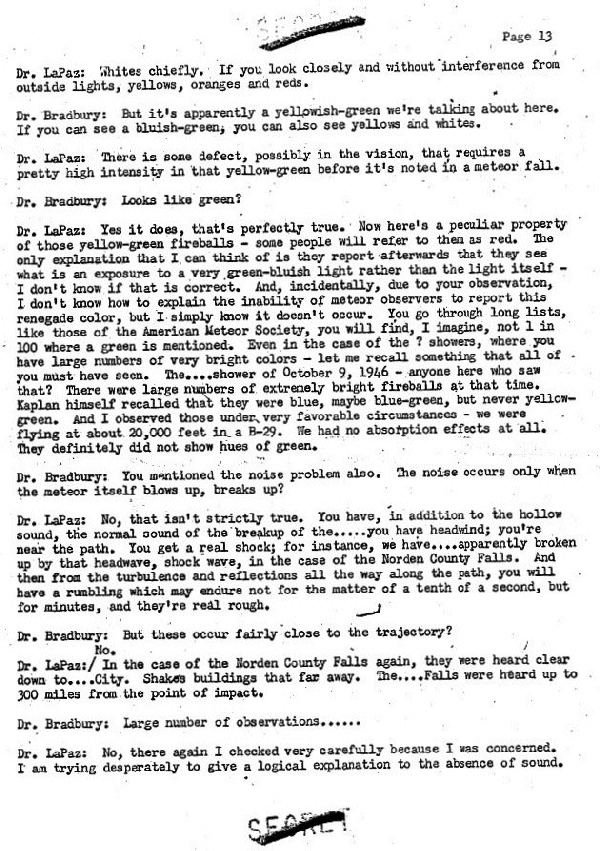This is one of the 24 pages of one of the many formerly secret official documents on this issue. These pages are the minutes of an important conference on the issue held at Los Alamos on February 16, 1949. Representatives of the Army, the FBI, the Air Force and scientists joined together. Dr. La Paz spent two years chasing the green fireballs and explains the issues. Dr. Edward Teller, one of the fathers of the atomic bomb, asks questions.
1 2 3 4 5 6 7 8 9 10 11 12 13 14 15 16 17 18 19 20 21 22 23 24

|
Dr. LaPaz: Whites chiefly. If you look closely and without interference from outside lights, yellows, oranges and reds.
Dr. Bradbury: But it's apparently a yellowish green we're talking about here. If you can see a bluish green, you can also see yellows and whites.
Dr. LaPaz: There is some defects, possibly in the vision, that requires a pretty high intensity in that yellow-green before it's noted in a meteor fall.
Dr. Bradbury: Looks like green?
Dr. LaPaz: Yes it does, that's perfectly true. Now there's a peculiar property of those yellow-green fireballs - some people will refer to them as red. The only explanation that I can think of is they report afterwards that they see what is an exposure to a very green-bluish light rather than the light itself - I don't know if that's correct. And, incidentally, due to your observation, I don't know how to explain the inability of meteor observers to report this renegade color, but I simply know it doesn't occur. You go through long lists, like those of the American Meteor Society, you will find, I imagine, not 1 in 100 where a green is mentioned. Even in the case of the? showers, where you have large numbers of very bright colors - let me recall something that all of you must have seen, The ... shower of October 9, 1946 - anyone here who saw that? There were large numbers of extremely bright fireballs at that time. Kaplan himself recalled that there were blue, maybe blue-green, but never yellow-green. and I observed those under very favorable circumstances - we were flying at about 20,000 feet in a B-29. We had no absorption effects at all. They definitely did not show hues of green.
Dr. Bradbury: You mentioned the noise problem also. The noise occurs only when the meteor itself blows up, breaks up?
Dr. LaPaz: No, that isn't strictly true. You have, in addition to the hollow sound, the normal sound of the breakup of the ... you have headwind, you're near the path. You get a real shock; for instance, we have ... apparently broken up by that headwave, shockwave, in the case of the Norden County Falls. And then from the turbulences and reflections all the way along the path, you will have a rumbling which may endure not for the matter of a tenth of a second, but for minutes, and they're real rough.
Dr. Bradbury: But these occur fairly close to the trajectory?
Dr. LaPaz: No. In the case of the Norden County Falls again, they were heard clear down to ... City. Shakes building that far away. The ... Falls were heard up to 300 miles from the point of impact.
Dr. Bradbury: Large number of observations ....
Dr. LaPaz. No, there again I checked very carefully because I was concerned. I am trying desperately to give a logical explanation to the absence of sound.
1 2 3 4 4 6 7 8 9 10 11 12 13 14 15 16 17 18 19 20 21 22 23 24